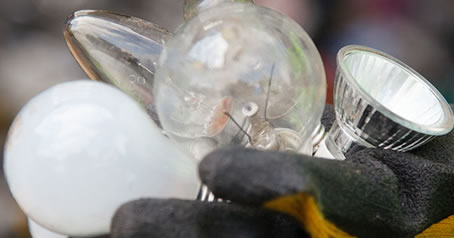Waste Lamps:
There are a number of types of waste lamps managed under the WEEE Ireland scheme such as:

- Fluorescent lamps – Fluorescent tubes, Compact Fluorescent Lamps (CFLs) & other types of gas discharge lamps.
- LED lamps
- Does NOT Include incandescent, domestic filament type light bulbs.
Safety Concerns Associated with Waste Lamps
Some key safety concerns associated with waste lamps are as follows:
- Waste lamps may contain a small amount of mercury vapour. This could be hazardous to health, particularly in strong concentrations. There is a risk of contact with this potentially hazardous material in the event of breakage of lamps.
- Sharp glass shards arising from the breakage of lamps could give rise to injury. Injuries could be made worse through contact with potentially harmful dust from within the lamp.
Recommended Precautions
To avoid contact with potentially harmful material such as broken glass or mercury vapour, the following precautions are recommended.
- Care should be taken when transporting waste lamps. Waste lamps should only be transported when the box is full. This is to minimise the risk of breakage and subsequent release of potentially harmful vapours, dusts and glass shards.
- Collection boxes should only be stacked if they are closed securely. Opened boxes do not retain their strength and stacking on top of open boxes is likely to result in lamp breakage and destabilisation of the stack.
- Care should be taken not to overfill lamp collection boxes since this could give rise to manual handling related injury. Additionally, overfilling the boxes increases the chances of box failure and breakage of the lamps and this could give rise to injury.
- Only waste fluorescent tube lamps should be stored in the long fluorescent tube lamp box. No other material should be stored in the box.
- Only waste compact fluorescent lamps (CFLs), short 2 foot fluorescent tube lamps or other relatively compact gas discharge lamps such as waste 2-D lamps should be stored in the CFL box. Other material such as waste batteries or light fixtures, etc. should not be stored in the box.
- Boxes/containers should not be stacked more than 3 tall to prevent damage to lower boxes in the stack and minimise the risk of breakage.
Further information

Recharge has produced some good guidance on lithium batteries in the form of a lithium-ion battery fact sheet. It is available here.
The Environmental Protection Agency (EPA) has produced some guidance on the storage of hazardous household waste. It can be found here.
Further information is available upon request from operations@weeeireland.ie
